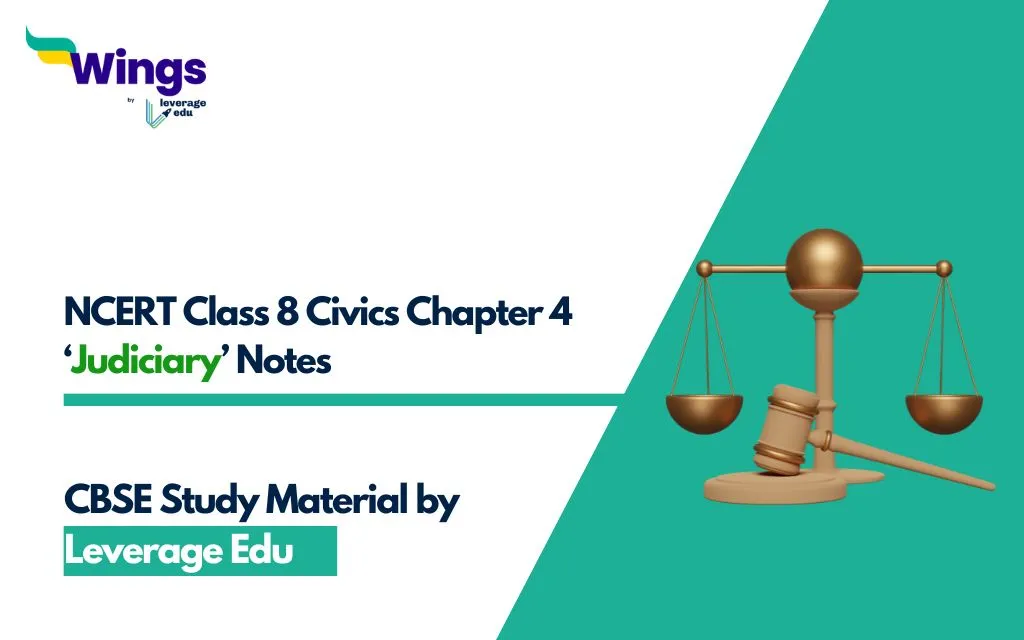NCERT Class 8 Civics Chapter 4 ‘Judiciary’ notes include an explanation of all topics in the lesson, which will help you understand the judicial system of India. We begin with a brief introduction to the chapter and move on to individual topics and important definitions in the lesson. Let’s start with Class 8 Political Science Chapter 4 notes.
Download NCERT Class 8 Civics Chapter 4 ‘Judiciary’ Notes PDF
Download NCERT Solutions Class 8 Civics Chapter 4 ‘Judiciary’ PDF
Contents
- 1 Introduction to NCERT Class 8 Civics Chapter 4 Judiciary Notes
- 2 Role of the Judiciary in India
- 3 What is an Independent Judiciary?
- 4 Structure of Courts in India
- 5 Difference between Criminal and Civil Law
- 6 Access to Justice and Public Interest Litigation
- 7 Role of Courts in Interpreting Fundamental Rights
- 8 Challenges to the Indian Judiciary
- 9 Important Definitions in NCERT Class 8 Civics Chapter 4 Judiciary
- 10 FAQs
Checkout notes of Class 8 Civics chapters here
Introduction to NCERT Class 8 Civics Chapter 4 Judiciary Notes
The judiciary is the third arm of the Indian government. Heading the judiciary is the Chief Justice of India, who operates from the Supreme Court of India. The Supreme Court of India is the apex court in India, which was established on 26 January 1950. When it was established, it was located in the Chamber of Princes in the Parliament House. The court moved to its present location on Mathura Road, New Delhi in 1958.
Role of the Judiciary in India
Courts handle a diverse range of issues, from interpersonal conflicts to matters of national importance. Their decisions cover various domains including education, interstate disputes, criminal justice, etc. Its functions are crucial for upholding the principles of democracy, ensuring the supremacy of the Constitution, and fostering a just and equitable society.
Dispute Resolution
Courts serve as a platform for resolving conflicts that arise between various entities within the country. They act as mediators in resolving conflicts among individuals, citizens and government, state governments, and center-state disputes.
Judicial Review
The judiciary holds the authority to invalidate laws if they contradict the fundamental principles outlined in the Constitution. This power is known as judicial review.
Upholding the Law and Fundamental Rights
Citizens have the right to seek justice from higher courts, such as the Supreme Court or High Courts, if they perceive their Fundamental Rights have been infringed upon. This mechanism ensures that individuals can seek legal recourse and protection against any infringement of their rights.
Also Read: Powers & Functions of the Indian Judiciary: Important Notes
What is an Independent Judiciary?
An independent judiciary refers to a system where the judiciary functions autonomously. This implies that it is free from undue influence or interference from other branches of government, such as the legislature or the executive.
In an independent judiciary, judges are expected to make decisions impartially. Their decisions should be based solely on the merits of the case, without being swayed by external pressures or considerations.
Key Aspects of an Independent Judiciary
- Separation of Powers: The foundational principle of the Constitution is separation of powers which means ensuring that each branch of government operates independently of one another.
- Appointment Process: Judges, especially in higher courts like the High Court and Supreme Court, are appointed with minimal interference from other branches of government. This ensures that judges are selected based on merit and independence rather than political allegiance.
- Security of Tenure: Once appointed, judges enjoy security of tenure. This safeguards judges from external pressures, ensuring they can perform their duties without fear of vengeance or retaliation by any person in power.
Role of an Independent Judiciary
Here are the key responsibilities and functions of an independent judiciary:
- To ensure checks and balances within the government. This prevents the abuse of power by the legislature and executive.
- To protect the Fundamental Rights of citizens by providing a mechanism for individuals to seek legal recourse if their rights are violated.
- To uphold the rule of law and ensure that justice is administered fairly and impartially, irrespective of the status or influence of the parties involved.
Also Read: How to Become a Judge: Qualifications, Colleges & Salary
Structure of Courts in India
In NCERT Class 8 Civics Chapter 4 Judiciary notes, we will now explore the different levels of the Judiciary and the appellate system of the courts in India.
Three Levels of Courts in India
The judiciary or courts in India have three levels, which are as follows:
- Lower Level: Subordinate or district courts, situated at district or Tehsil levels, handle various cases.
- Intermediate Level: Each state has a High Court, the highest court within the state.
- Apex Level: The Supreme Court of India, located in New Delhi, is presided over by the Chief Justice of India.
Appellate Jurisdiction in Indian Judiciary
Decisions made by higher courts are binding on lower courts, reflecting an integrated judicial system. A prominent part of the integrated judicial system of India is the appellate jurisdiction, which allows individuals to appeal to higher courts if they believe the judgment of a lower court is unjust.
Case Study: State (Delhi Administration) vs Laxman Kumar and Others (1985)
In 1980, Laxman Kumar’s wife, Sudha Goel, died due to burns in Delhi. During the trial, Laxman Kumar and his family were alleged to be responsible for Sudha Goel’s death. Sudha’s family and lawyers suspected torture at the hands of her in-laws. After considering the evidence and arguments presented by Sudha’s lawyers, the Trial Court convicted Laxman, his mother Shakuntala, and brother-in-law Subash Chandra, sentencing them to death.
Appeals Process
Discontent with the judgment, Laxman and his family appealed to the High Court in 1983. High Court acquitted the accused, attributing Sudha’s death to an accidental fire caused by a kerosene stove.
Women’s groups protested against the High Court’s decision, appealing to the Supreme Court through the Indian Federation of Women Lawyers.
In 1985, the Supreme Court heard the appeal against the High Court’s decision. The apex court found Laxman and his mother guilty but acquitted Subash due to insufficient evidence. The bench of the highest court in India sentenced Laxman and his mother to life imprisonment, thereby, differing from the High Court’s judgment.
Significance of the Case
- It illustrates the appellate system in India, where cases can be reviewed by higher courts.
- Also, it highlights the role of the Supreme Court in ensuring justice and correcting potential miscarriages of justice.
- Lastly, it demonstrates the importance of judicial independence and the separation of powers in upholding the rule of law.
Also Read: Appointment of Judges of Supreme Court: A Guide
Difference between Criminal and Civil Law
Here are the key differences between criminal and civil law:
| Criminal Law | Civil Law |
| Deals with all actions defined as an offence by the law. For instance: murder, dowry, theft, etc. | Deals with harm to the rights of any person. For instance, disputes relating to the sale of land, divorce cases, purchase of goods, child custody cases, rent matters, etc. |
| To initiate a criminal case, an individual needs to lodge a First Information Report (FIR) with the police, who are bound to investigate the crime. After the initial investigation, the case is filed in the court of law. | To initiate a civil case, the affected party needs to file a petition before the relevant court of law. |
| If the court finds the accused guilty, the court will convict the accused. The court can send the accused to jail and even impose a fine. | The court grants relief asked for by the affected party. |
Also Read: What is Collegium System?
Access to Justice and Public Interest Litigation
All citizens have the right to seek justice through courts, especially in cases where Fundamental Rights are violated. However, accessing courts has been historically challenging for the poor due to financial constraints, paperwork, and time-consuming legal procedures.
Public Interest Litigation
The Supreme Court devised Public Interest Litigation (PIL) in the early 1980s to enhance access to justice. The apex court allows any individual or organisation to file a PIL in the High Court or Supreme Court on behalf of those whose rights were infringed. Thus, PIL simplified the legal process, allowing even informal means of communication like letters or telegrams to be treated as PIL.
Impact of PIL: Examples
Over the years, many citizens, groups of individuals, and organisations have filed PILs to secure justice. Here are some ways in which PILs have helped secure justice:
- Rescuing bonded labourers from inhumane work conditions.
- Securing the release of prisoners in Bihar who were unlawfully detained after completing their sentences.
- Establishment of the mid-day meal scheme in government and government-aided schools to address the Right to Food.
Also Read: How to Become a Magistrate in India?
Role of Courts in Interpreting Fundamental Rights
Courts play a critical role in interpreting Fundamental Rights, ensuring their protection and enforcement. For instance, the Olga Tellis vs Bombay Municipal Corporation judgment expanded the scope of Fundamental Rights by recognizing the Right to Livelihood as inherent in the Right to Life.
Case Study: Olga Tellis vs Bombay Municipal Corporation
The judgment establishes the Right to Livelihood as an essential part of the Right to Life guaranteed by Article 21 of the Indian Constitution. With this judgement, the Supreme Court ensured that the judiciary upholds and protects the socio-economic rights of citizens alongside civil and political rights. The decision provided legal protection to marginalised communities, such as slum dwellers, by acknowledging the importance of their livelihoods and preventing arbitrary evictions.
Interpretation of Right to Life
- The Right to Life extends beyond the preservation of physical existence and includes the right to livelihood for dignified living.
- Courts highlighted that the Right to Life is not limited to the absence of the death penalty but includes the right to sustain oneself through a livelihood.
Implications of Eviction on Livelihood
- The Supreme Court emphasised that eviction from slums or pavements deprives individuals of their means of livelihood, leading to the violation of their Right to Life.
- In addition, it also highlighted the direct link between eviction and deprivation of livelihood, as individuals often reside in such areas due to employment opportunities nearby.
Challenges to the Indian Judiciary
With all its achievements, the Indian Judiciary is marred by several challenges and criticism, owing to the inaccessibility of justice and some controversial judgements.
Inaccessibility to Justice
Long delays in hearing cases hinder access to justice, leading to the perception that “justice delayed is justice denied.” Legal proceedings often take years to conclude, posing challenges for the common person seeking redress.
Controversial Judgements
Recent judgments on issues like evictions have drawn criticism for allegedly working against the interests of the common person. Activists argue that recent judgments differ significantly from earlier ones, such as Olga Tellis vs Bombay Municipal Corporation, which prioritized protecting the livelihoods of slum dwellers.
Download NCERT Class 8 Civics Chapter 4 ‘Judiciary’ Notes PDF
Download NCERT Solutions Class 8 Civics Chapter 4 ‘Judiciary’ PDF
Download notes of Class 8 Civics chapters here
Important Definitions in NCERT Class 8 Civics Chapter 4 Judiciary
- Acquit: In legal terms, acquit denotes the court’s decision declaring an individual not guilty of the crime they were accused of during the trial process.
- To Appeal: With respect to the Indian judiciary, to appeal signifies the submission of a petition to a higher court, seeking a review of a case that has already been adjudicated by a lower court.
- Compensation: In the context of the judiciary, compensation refers to monetary reparation provided to redress an injury or loss suffered by an individual or entity.
- Eviction: In the judicial system eviction pertains to the enforced removal of individuals from the land or homes they currently inhabit.
- Violation: In the judiciary, violation encompasses both the act of contravening a law and the breach or infringement of Fundamental Rights.
Explore NCERT Solutions of all Class 8 Civics chapters here:
Explore other topics related to the Indian Polity here
| The Basic Structure Doctrine: Safeguarding Constitutional Integrity | The Four Pillars of Democracy: Notes |
| Salient Features of Indian Constitution | What is CJI Full Form? |
| Types of Lawyer: Salaries, Universities, and More | What is the Full Form of APO? |
| One Nation One Election Essay | Essay on Democracy |
| What is Representative Democracy? | 11 Features of Democracy in India |
FAQs
Ans: You can download NCERT chapters at https://ncert.nic.in/textbook.php
Ans: Yes. NCERT notes by Leverage Edu are helpful for unit tests and term exams.
Ans: You can download NCERT Class 8 Civics notes at Leverage Edu.
Follow Leverage Edu for complete study material on CBSE Notes of Class 8 Civics.
 One app for all your study abroad needs
One app for all your study abroad needs














